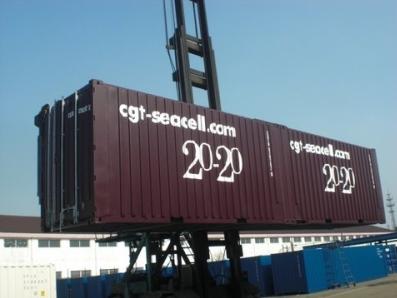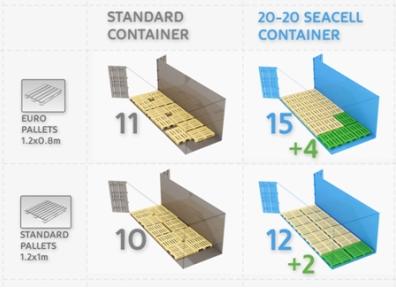
A new container design is set to change the economics of shipping palletised cargo, allowing cargo owners and consolidators to increase significantly the volume of cargo shipped at any one time.
UK-based container design company Container Group Technology (CGT) Ltd has released the 20-20 SeaCell Container. From the outside the patented ‘20-20’ looks little different from a conventional ISO 20ft shipping container, however, subtle innovations on the outside and inside of the container enable the unit to provide for 36% greater pallet space.
In practical terms, this means that for each tier, 15 Euro-pallets (1200mm x 800mm) can be loaded into the container instead just 11 Euro-pallets in a standard ISO 20ft dry container. With standard ISO pallets (1200mm x 1000mm), the 20-20 can load 12 units, two more than in a conventional 20ft container (see graphic).
And by using 100% of the floor area, pallets fit snugly together inside the container making the 20-20 ideal for using lightweight slip-sheets or paper pallets, thereby reducing costs and increasing useable volume and payload at the same time.
The 20-20 SeaCell Container achieves this feat by being exactly 20ft (6096mm) in length and 2426mm wide internally. Standard 20ft containers are, in fact, 19ft 10½ ins (6058mm) long x 7ft 7¾ ins (2330mm) wide internally. Thus the internal length of the 20-20 allows it to accommodate the additional four Euro-pallets or two ISO pallets per tier. The door opening width is 2408mm which allows fork-lift trucks to load pallets two or three at a time.

Twin-lift container
In addition, two of the 20-20 containers can be easily locked together from the outside with no special tools to make a 40ft container, but again with significantly greater internal volume than standard. Two 20-20 containers will carry six more pallets than one standard 40ft container. It is also possible to mix Euro & Standard pallets in the same 20-20 and still have 100% pallet utilisation.
The 20-20 is fitted with larger corner castings of the type typically used in flatrack containers, enabling them to be lifted by standard 20ft or 40ft spreaders, loaded singly or as a pair into a containership’s 40ft cells, or onto any current road chassis and rail wagon.
An integral locking mechanism in the corner casting is activated from the outside of the container. In just a few minutes, the two 20-20 containers can be securely locked together and lifted as a single ‘40ft’ unit. In the standard configuration, two 20-20s are joined at the front ends, ie, with the doors accessible at each end of the combined containers. However, if requested CGT can also position the locking mechanism at the door-end corner castings so that the two 20-20 units are effectively sealed until reaching their final destination. This is an important feature for high-value or sensitive cargoes.
Lifting two 20ft containers together has been made possible in the past decade by innovations in container lifting technology, and it has become increasingly popular with shipping lines and container port terminals as a way of loading and discharging ships faster and more efficiently.
However, it is only now, with the introduction of the 20-20 SeaCell Container, that the ability to lock and lift two 20ft containers and handle them as a single 34 ton maximum gross weight (MGW) unit has been made possible.
Prototypes of the 20-20 container have been built and fully tested in China, and the new design is being made available for sale or lease.





